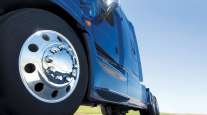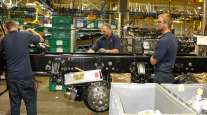OEMs Vie for Larger Share of Parts Market as Independent Distributors Add Services
The business of selling truck parts is changing as original equipment manufacturers and their dealers try to expand their share of the $30 billion market.
Additionally, independent distributors are adding maintenance and repair services to augment the sale of parts, and new companies are entering the market to meet growing demand for low-cost replacement parts and higher-quality refurbished components.
“We want to sell parts for our trucks and other makes, too,” said Joel Larsen, vice president of product management and pricing at Navistar International Corp., where sales of Fleetrite brand truck parts are growing 25% annually and providing a new source of revenue for the truck and engine manufacturer and its 700 dealers in the United States and Canada.
Annual sales of Fleetrite parts have grown to $150 million from $10 million over the past six years.
“We’ve upped our game,” Larsen said.
In November, Navistar introduced its Diamond Edge Certified Program to recognize dealers that meet certain efficiency standards by, among other things, having parts on hand for the most common maintenance activities.
By implementing new systems to track inventory and process orders, the company’s vision is to get parts into the hands of a repair technician or fleet customers in minutes rather than days, Larsen said.
Mack Trucks is also rolling out a certification program where dealers designate “uptime bays” for trucks needing repairs requiring fewer than four hours of work to complete and where technicians use the latest electronic tools and telematics to diagnose problems more quickly.
“The Mack Certified Uptime Center pilot has significantly reduced the amount of time we’re spending on diagnostics and has also allowed an increase in technician productivity,” said Jon Miller, service manager at Vanguard Truck Center in Phoenix, one of 21 locations that tested the program in 2015.
Other OEMs are expanding and upgrading their parts distribution activities.
Paccar Inc., parent of Kenworth Truck Co. and Peterbilt Motors Co., said global revenue from the sale of parts exceeded $3 billion in 2014 and has grown at an annual rate of 8% over a decade. Paccar ships parts from nine distribution centers in North America, two in South America, four in Europe and one in Australia.
Daimler Trucks North America, which sells new and remanufactured parts and accessories under the Alliance Truck Parts brand, has taken several steps, including a dedicated delivery service, to reduce the time it takes to get parts to its maintenance shops and to customers.
“A truck being down for multiple days due to [lack of] parts availability is unacceptable,” said Catherine Auckland, director of aftermarket marketing for Alliance. “Daimler Trucks North America has made considerable investments to ensure a high level of parts availability, including a new parts distribution center in Dallas and a host of systems and new processes to ensure timely delivery of parts.”
DEX Heavy Duty Parts, which is based in Advance, North Carolina, is owned by Volvo Trucks, a sister company to Mack Trucks within Volvo Group, and offers recycled, rebuilt and surplus parts for all makes and models of trucks.
Sales of aftermarket parts for Classes 6-8 U.S. trucks, trailers and chassis represent a $30 billion-a-year business, with $16.3 billion more spent annually on replacement tires, according to data compiled by MacKay & Co., a Lombard, Illinois-based research and consulting firm. A separate study in Mexico found sales of replacement parts for trucks, buses and trailers at $3 billion in 2015.
John Blodgett, MacKay vice president of sales and marketing, said truck dealers and OEMs control almost half of the market for parts — 48% — based on the firm’s latest survey of U.S. and Canadian buyers and sellers. Heavy-duty distributors represent 19% of the market, with the remaining share made up of independent garages, 9%; engine manufacturers and dealers, 8%; specialists, 6%; auto parts distributors, 4%; and others.
“It’s a very competitive market,” Blodgett noted, even though industry consolidation has reduced the number of companies in both the OEM and independent distributor channels.
While the number of companies selling parts may be fewer, those that remain are bigger and have greater service capabilities, said Jim Pennig, vice president of business development for Vipar Heavy Duty. The Crystal Lake, Illinois-based company provides product, marketing and sales support for 120 distributors with a total of 560 locations in North America. In 2014, Vipar acquired Power Heavy Duty, another organization that represents 140 distributors and service providers with 205 U.S. and Canadian locations.
Vipar and Power have maintained separate membership and identities in the market, Pennig said, because of differences in the type of business represented by each of the brands. Power HD members tend to focus on maintenance and repair services along with the sale of parts while Vipar HD members tend to operate a more traditional warehouse distribution business model.
Combining ownership of the two organizations — with more than 750 locations and $2.5 billion in annual sales — did have some benefits, Pennig explained. It reduced administrative expenses and strengthened relations with industry suppliers while helping to negotiate better prices. Most important, Pennig said, the company has been able to provide a technology platform that both organizations can use to process orders and to market products and services.
Past attempts by investors to buy up local distributors and create a unified corporate organization didn’t succeed, Pennig said, because they eliminated sales staff that had developed important relationships with customers, and efforts to negotiate volume discounts with a single vendor resulted in a reduction in the variety of products on the shelf and, ultimately, a loss of sales.
“There are still efficiencies to be gained, but you can’t lose the expertise,” Pennig said.
Other major parts distribution groups include FleetPride Inc., TruckPro and HDA Truck Pride. FleetPride, which is based in Irving, Texas, operates more than 260 locations in 45 states and offers rebuilt brake shoes and driveline components along with truck and trailer repair services at some locations. Sales in 2014 topped $1 billion. TruckPro of Memphis, Tennessee, claims more than 150 U.S. and Canadian locations after the purchase in July of Power Train, a company that provides truck parts, fleet maintenance and mobile repair services in Indiana, Ohio and Kentucky.
HDA Truck Pride, which is based in St. Louis, is the result of a merger between a long-standing parts buying group, Heavy Duty America, and Truck Pride, an independent parts distributor, in 2000.
Tina Alread, director of sales and marketing for HDA Truck Pride, said companies that specialize in truck parts face new competition from auto parts distributors, such as O’Reilly’s Auto Parts, on one side and from industrial distributors, such as Grainger Inc. and Imperial Supplies, on the other.
LKQ Corp., a multibillion-dollar company that sells parts from salvaged cars and trucks, represents another entry into the truck parts business. Based in Chicago, LKQ operates 26 heavy-duty truck facilities in the United States and Canada and bought 6,000 vehicles in 2014, some of which are dismantled for parts and some of which are resold. Some parts are also remanufactured and offered for sale.
To counter the threat posed by new competitors and to be more competitive with OEM dealerships, Alread said, she encourages independent parts suppliers to add maintenance and repair services.
“We see an increase in the number of shops of about 5% to 8% a year,” Alread said. “You don’t see any dealerships selling parts without service. Why should we be any different?”
It’s also important for independent parts distributors to keep up with changes in technology, such as electronic logging devices, so they can be in a position to supply replacement parts or to service the products when they break down.
Alread said her organization has partnered with a company called Imatics to develop logging devices and other telematics components that parts distributors can sell.
Gerard Zentner, the owner of Capital Gear Ltd. in Edmonton, Alberta, said his company, which specializes in rebuilding drivetrain components, has been able to increase sales, despite a downturn in oil-field activity, by emphasizing the quality of rebuilt transmissions and differentials and by projecting an image of professionalism to counter what is seen as a poor perception of the industry by the public.
“We want to be more respected,” he said.
Zentner said trucks and truck parts are more sophisticated and require more expertise to service and sell.
At W.W. Williams Inc. of Columbus, Ohio, a distributor for Detroit engines and Allison transmissions for decades, executives are parlaying that expertise to provide a broader range of repair services and parts for customers.
“We have to be expert in what we sell,” said Wally Williams, vice president of business process and parts. “Otherwise, it’s just a transaction.”
The Internet is playing a bigger role in parts distribution, although the percentage of people who make purchases online remains relatively small.
Only 17% of buyers surveyed by MacKay & Co. made online purchases, while 31% used the telephone and 26% made purchases in person at the parts counter in the store.
“There is this trend now that customers price-shop everything,” Alread of HDA Truck Pride said. “But nickel-and-diming everyone to death is not as efficient as forming a relationship and sharing data so we can have the part when they need it to reduce downtime. You’ll still have price shoppers that create unnecessary special deliveries, but working more efficiently seems to be a bigger trend.”




